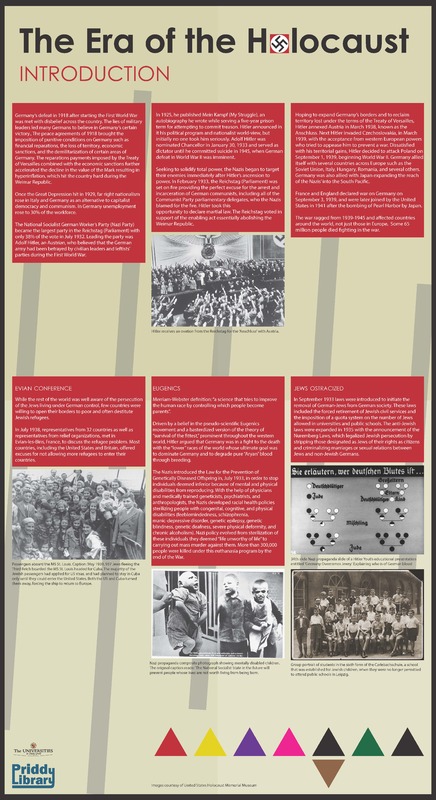Introduction 1
Germany’s defeat in 1918 after starting the First World War
was met with disbelief across the country. The lies of military
leaders led many Germans to believe in Germany’s certain
victory. The peace agreements of 1918 brought the
imposition of punitive conditions on Germany such as
financial reparations, the loss of territory, economic
sanctions, and the demilitarization of certain areas of
Germany. The reparations payments imposed by the Treaty
of Versailles combined with the economic sanctions further
accelerated the decline in the value of the Mark resulting in
hyperinflation, which hit the country hard during the
Weimar Republic.
Once the Great Depression hit in 1929, far right nationalism
rose in Italy and Germany as an alternative to capitalist
democracy and communism. In Germany unemployment
rose to 30% of the workforce.
The National Socialist German Worker’s Party (Nazi Party)
became the largest party in the Reichstag (Parliament) with
only 38% of the vote in July 1932. Leading the party was
Adolf Hitler, an Austrian, who believed that the German
army had been betrayed by civilian leaders and leftists’
parties during the First World War.
In 1925, he published Mein Kampf (My Struggle), an
autobiography he wrote while serving a five-year prison
term for attempting to commit treason. Hitler announced in
it his political program and nationalist world-view, but
initially no one took him seriously. Adolf Hitler was
nominated Chancellor in January 30, 1933 and served as
dictator until he committed suicide in 1945, when German
defeat in World War II was imminent.
Seeking to solidify total power, the Nazis began to target
their enemies immediately after Hitler’s ascension to
power. In February 1933, the Reichstag (Parliament) was
set on fire providing the perfect excuse for the arrest and
incarceration of German communists, including all of the
Communist Party parliamentary delegates, who the Nazis
blamed for the fire. Hitler took this
opportunity to declare martial law. The Reichstag voted in
support of the enabling act essentially abolishing the
Weimar Republic.
Hoping to expand Germany’s borders and to reclaim
territory lost under the terms of the Treaty of Versailles,
Hitler annexed Austria in March 1938, known as the
Anschluss. Next Hitler invaded Czechoslovakia, in March
1939, with the acceptance from western European powers
who tried to appease him to prevent a war. Dissatisfied
with his territorial gains, Hitler decided to attack Poland on
September 1, 1939, beginning World War II. Germany allied
itself with several countries across Europe such as the
Soviet Union, Italy, Hungary, Romania, and several others.
Germany was also allied with Japan expanding the reach
of the Nazis’ into the South Pacic.
France and England declared war on Germany on
September 3, 1939, and were later joined by the United
States in 1941 after the bombing of Pearl Harbor by Japan.
The war ragged from 1939-1945 and affected countries
around the world, not just those in Europe. Some 65
million people died fighting in the war.
EVIAN CONFERENCE
While the rest of the world was well aware of the persecution
of the Jews living under German control, few countries were
willing to open their borders to poor and often destitute
Jewish refugees.
In July 1938, representatives from 32 countries as well as
representatives from relief organizations, met in
Evian-les-Bins, France, to discuss the refugee problem. Most
countries, including the United States and Britain, offered
excuses for not allowing more refugees to enter their
countries.
EUGENICS
Merriam-Webster definition: “a science that tries to improve
the human race by controlling which people become
parents”.
Driven by a belief in the pseudo-scientific Eugenics
movement and a basterdized version of the theory of
“survival of the fittest,” prominent throughout the western
world, Hitler argued that Germany was in a fight to the death
with the “lower” races of the world whose ultimate goal was
to dominate Germany and to degrade pure “Aryan” blood
through breeding.
The Nazis introduced the Law for the Prevention of
Genetically Diseased Offspring in, July 1933, in order to stop
individuals deemed inferior because of mental and physical
disabilities from reproducing. With the help of physicians
and medically trained geneticists, psychiatrists, and
anthropologists, the Nazis developed racial health policies
sterilizing people with congenital, cognitive, and physical
disabilities (feeblemindedness, schizophrenia,
manic-depressive disorder, genetic epilepsy, genetic
blindness, genetic deafness, severe physical deformity, and
chronic alcoholism). Nazi policy evolved from sterilization of
these individuals they deemed “life unworthy of life” to
carrying out mass murder against them. More than 300,000
people were killed under this euthanasia program by the
end of the War.
JEWS OSTRACIZED
In September 1933 laws were introduced to initiate the
removal of German-Jews from German society. These laws
included the forced retirement of Jewish civil services and
the imposition of a quota system on the number of Jews
allowed in universities and public schools. The anti-Jewish
laws were expanded in 1935 with the announcement of the
Nuremberg Laws, which legalized Jewish persecution by
stripping those designated as Jews of their rights as citizens
and criminalizing marriages or sexual relations between
Jews and non-Jewish Germans.
